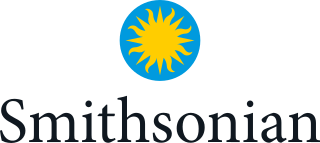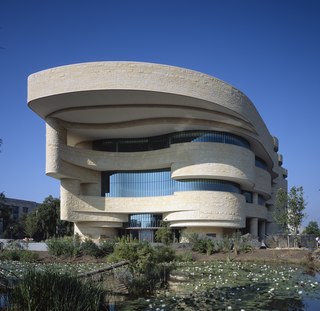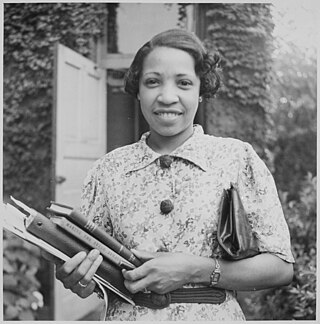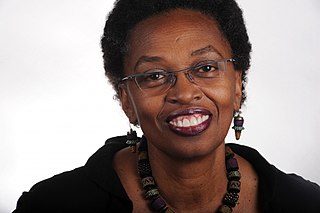Related Research Articles

The Smithsonian Institution, or simply the Smithsonian, is a group of museums, education and research centers, the largest such complex in the world, created by the U.S. government "for the increase and diffusion of knowledge". Founded on August 10, 1846, it operates as a trust instrumentality and is not formally a part of any of the three branches of the federal government. The institution is named after its founding donor, British scientist James Smithson. It was originally organized as the United States National Museum, but that name ceased to exist administratively in 1967.

The National Zoological Park, commonly known as the National Zoo, is one of the oldest zoos in the United States. It is part of the Smithsonian Institution and does not charge admission. Founded in 1889, its mission is to "provide engaging experiences with animals and create and share knowledge to save wildlife and habitats".

The National Museum of the American Indian is a museum in the United States devoted to the culture of the indigenous peoples of the Americas. It is part of the Smithsonian Institution group of museums and research centers.

The National Museum of Natural History is a natural history museum administered by the Smithsonian Institution, located on the National Mall in Washington, D.C., United States. It has free admission and is open 364 days a year. In 2022, with 3.9 million visitors, it was the most-visited museum in the United States.

The National Museum of the American Indian–New York, the George Gustav Heye Center, is a branch of the National Museum of the American Indian at the Alexander Hamilton U.S. Custom House in Manhattan, New York City. The museum is part of the Smithsonian Institution. The center features contemporary and historical exhibits of art and artifacts by and about Native Americans.

Cooper Hewitt, Smithsonian Design Museum is a design museum housed within the Andrew Carnegie Mansion in Manhattan, New York City, along the Upper East Side's Museum Mile. It is one of 19 museums that operate within the Smithsonian Institution and is one of three Smithsonian facilities located in New York City, the other two being the National Museum of the American Indian's George Gustav Heye Center in Bowling Green and the Archives of American Art New York Research Center in the Flatiron District. Unlike other Smithsonian museums, Cooper Hewitt is not free to the public and charges an admissions fee to visitors. It is the only museum in the United States devoted to historical and contemporary design. Its collections and exhibitions explore approximately 240 years of design aesthetic and creativity.

The Freer Gallery of Art is an art museum of the Smithsonian Institution in Washington, D.C. focusing on Asian art. The Freer and the Arthur M. Sackler Gallery together form the National Museum of Asian Art in the United States. The Freer and Sackler galleries house the largest Asian art research library in the country and contain art from East Asia, South Asia, Southeast Asia, the Islamic world, the ancient Near East, and ancient Egypt, as well as a significant collection of American art.

Lois Mailou Jones (1905-1998) was an artist and educator. Her work can be found in the collections of the Smithsonian American Art Museum, The Metropolitan Museum of Art, the National Museum of Women in the Arts, the Brooklyn Museum, the Museum of Fine Arts, Boston, Muscarelle Museum of Art, and The Phillips Collection. She is often associated with the Harlem Renaissance.

The Corcoran School of the Arts and Design is the professional art school of the George Washington University, in Washington, D.C. Founded in 1878, the school is housed in the Corcoran Gallery of Art, the oldest private cultural institution in Washington, located on The Ellipse, facing the White House. The Corcoran School is part of GW's Columbian College of Arts and Sciences and was formerly an independent college, until 2014.

The National Museum of African Art is the Smithsonian Institution's African art museum, located on the National Mall of the United States capital. Its collections include 9,000 works of traditional and contemporary African art from both Sub-Saharan and North Africa, 300,000 photographs, and 50,000 library volumes. It was the first institution dedicated to African art in the United States and remains the largest collection. The Washington Post called the museum a mainstay in the international art world and the main venue for contemporary African art in the United States.

Richard Kurin, an American cultural anthropologist, museum official and author, is the Acting Provost and Under Secretary for Museums and Research at the Smithsonian Institution. He is a key member of the senior team managing the world's largest museum and research complex with 6,500 employees and a $1.4 billion annual budget, caring for more than 139 million specimens, artifacts and artworks, working in 145 countries around the globe, hosting some 30 million visitors a year, and reaching hundreds of millions online and through the Smithsonian's educational programs and media outreach. Kurin is particularly responsible for all of the national museums, scholarly and scientific research centers, and programs spanning science, history, art and culture.

Smithsonian Libraries and Archives is an institutional archives and library system comprising 21 branch libraries serving the various Smithsonian Institution museums and research centers. The Libraries and Archives serve Smithsonian Institution staff as well as the scholarly community and general public with information and reference support. Its collections number nearly 3 million volumes including 50,000 rare books and manuscripts.

The National Museum of the American Latino is a future Smithsonian Institution museum dedicated to highlighting the contributions of American Latinos in U.S. history and culture. It will be situated in a "signature location on the National Mall" in Washington, D.C., in the United States. A commission to study the idea of the museum was originally created in 2008, and its May 2011 report called for federal legislation to establish a museum. Legislation was subsequently introduced in Congress and the Consolidated Appropriations Act, 2021 established the museum.
Michael Atwood Mason is an American folklorist and museum professional. He currently serves as CEO and Executive Director of President Lincoln's Cottage and was, up to February 2021, the Director of the Smithsonian Center for Folklife and Cultural Heritage.
Washington, D.C., is the capital of the United States and home to over 600,000 residents. Its diversity has fostered a culture that is unique to the country. Washington, D.C., has a wide range of restaurants, theaters, historic sites, and events.

JoAllyn Archambault is a cultural anthropologist with an expertise in Native American people. She is the director of the Smithsonian Institution's American Indian Program. Born to a Sioux father and Creek mother, Archambault was raised in Sioux traditions and is a member of the Standing Rock Sioux Tribe of North and South Dakota. Archambault has made a great contribution to anthropology by providing an insider's perspective to her research on Native American people.
Conservation and restoration at the Smithsonian Institution deals with the care of the 138 million artifacts located in the collections of Smithsonian Institution. Work is conducted by one research center, the Museum Conservation Institute (MCI), and by conservators at the Smithsonian's museums, galleries, zoo. Smithsonian conservators provide myriad services to their units, including exhibit preparation of the museum collection and loan objects, advising on object care, training for future generations of conservationists, engaging in routine preventive care on a daily basis, conducting research projects related to the collections, and examining objects for evidence of manufacturing techniques and previous restorations All conservation labs collectively further the mission of the Smithsonian Institution, "the increase and diffusion of knowledge." Founded in 1846 the Smithsonian is the world's largest museum and research complex, consisting of 19 museums and galleries, the National Zoological Park, and nine research facilities.

Claudine K. Brown was an American museum director and educator and nonprofit executive. She was best known for her work at the Smithsonian Institution, where she was Director of Education, responsible for directing its work to help educate K-12 students. She was also a specialist in African-American history.
Pilar Frank O'Leary is a business consultant, former lawyer, corporate executive and not-for-profit director. She is Founder and President of PFO Advisory Group, which primarily advises institutions working with Latin America and Spain on policy and business development matters. Previously, O'Leary worked as a corporate lawyer and business executive, and served as Director of the Smithsonian Latino Center from 2005–2008. O'Leary resigned from her role with the Smithsonian after accusations that she solicited personal gifts during her role there.
References
- ↑ Dubb, Steve (2021-01-12). "The Long Road to Cultural Representation: Two New Smithsonian Museums Born". Non Profit News | Nonprofit Quarterly. Retrieved 2021-01-22.
{{cite web}}: CS1 maint: url-status (link) - 1 2 "About the Center". latino.si.edu. Archived from the original on June 2, 2016. Retrieved May 18, 2016.
- 1 2 3 Lara, Isabel (June 26, 2007). "Smithsonian Latino Center's Young Ambassadors Arrive for Week of Cultural Programs in Washington, D.C." (PDF). Smithsonian Institution. Archived from the original (PDF) on February 16, 2017. Retrieved May 18, 2016.
- ↑ "Smithsonian Latino Center Staff". latino.si.edu. Archived from the original on June 11, 2016. Retrieved May 18, 2016.
- 1 2 3 "Declaration" (PDF). The Washington Post . Archived (PDF) from the original on February 16, 2017. Retrieved September 12, 2017.
- ↑ "Smithsonian Latino Virtual Museum". latino.si.edu. Archived from the original on May 10, 2016. Retrieved May 18, 2016.
- ↑ "Young Ambassadors Program". latino.si.edu. Archived from the original on May 10, 2016. Retrieved May 18, 2016.
- ↑ "Con Sabor!". Washington Life Magazine "Substance and Style" Issue. 2006. Archived from the original on June 16, 2016. Retrieved May 18, 2016.